Content
- 1 The origin of violets
- 2 Violet description
- 3 Hybrid varieties
- 4 The most famous varieties
- 5 We buy violets
- 6 What violets love
- 7 Watering violets
- 8 Plant feeding
- 9 Reproduction of violets by leaf cuttings
- 10 Landing kids
- 11 Reproduction by stepchildren
- 12 Choosing pots
- 13 Violet care
- 14 Types and varieties of Saintpaulia, a description of a houseplant
- 15 Name difference
- 16 What varieties are cultivated at home?
- 17 Useful properties of violets
- 18 Indoor violet - description
- 19 Types and varieties of violets with photos, names, descriptions
Now I want to tell you about my, perhaps, the most beloved violets - fantasy varieties. Their flower is strewn with strokes, specks and dots of a different color in relation to the main field. Such a starry sky in miniature, mysterious, enticing, deep. Some of the "fantasies" are even called quite "cosmic".
The group of fantasy violets got their name from the first representative that appeared in 1949 and was called Fantasy. It was a blue fantasy cultivar over a lavender field of petals.
There are 2 types of fantasy: direct and reverse. The first type is the most common. This is when strokes and spots of a dark color, usually blue or purple, are scattered over a light field, most often pink. These are, for example, such well-known varieties as B-Man's Comiso, Playful Spectrum, Podvechnaya, RS-Sea Princess, Jan-Tornado, etc.
For varieties with reverse fantasy, the opposite is true: the field is darker than the fantasy itself. There are much fewer of them. Famous ones: my favorite Phobos, AE-Aries, as well as Startrick, Rainbow's Quiet Riot, Fisher's Leon, etc.
A fantasy pattern can be located randomly along the entire field of the petal, or it can form a beautiful border along its edges. In any case, such violets are very effective.
In cultivation, fantasy varieties differ little from the rest of the violets. However, it has been noticed that the amount of fantasy and the intensity of the color increases in 2 and 3 blooms. In the first place, strokes and dots may be few in number or even completely absent, especially when it comes to red fantasy over a pink field.
There is also a relationship between the quality of flowering fantasy violets and the temperature of their content. In cool conditions, such Saintpaulias more often and more correctly repeat the varietal color.
But in reproduction, fantasy violets have some peculiarities. Genetically, such varieties are unstable and do not always transfer color when propagated by a leaf. Therefore, it is better to purchase such varieties with cuttings with a blooming rosette according to the variety and grow all the children before flowering, choosing the most beautiful and brightest.
I also often hear from collectors that in the second generation, when after removing the babies, the leaf is re-rooted, there are more chances of getting varietal flowering. I have yet to verify this fact. In the meantime, I do not need children in such quantities, and I rarely re-root the sheets.
The likelihood of flowering in a variety increases sharply when it comes to reproduction by stepchildren.
Sometimes fantasy varieties give amazingly beautiful sports worthy of their own name. You can read more about sports here.
And in conclusion, I offer a short video about my collection of fantasy violets.
Almost every grower has a violet. And how can you refuse such beauty. In nature, there are about 500 species of this plant. The territory of their distribution is almost the entire globe. Violet varieties differ in size, color and many other features that only specialists know about. Admiring their beauty and amazing tenderness of flowers, I want to preserve it for a long time and increase it. Each variety of violets is good in its own way, but they require the same care. We will talk about how to grow these amazing plants in this article.
The origin of violets
This beautiful flower is native to East Africa. Until now, many rare varieties of violets are found only there and are even protected. The second name of this plant is saintpaulia. In their natural environment, they grow near waterfalls, in the coastal zone of rivers, where there is a lot of fog and mist.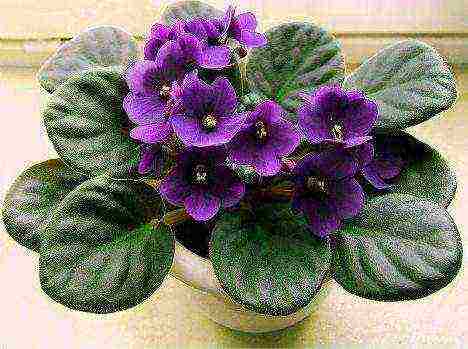 This flower was discovered by Baron Walter Saint-Paul near the Usambar Mountains. He struck him with his beauty and tenderness. There are many violet-like plants in nature, but only one species, Saintpaulia, was able to take root under conditions of home breeding.
This flower was discovered by Baron Walter Saint-Paul near the Usambar Mountains. He struck him with his beauty and tenderness. There are many violet-like plants in nature, but only one species, Saintpaulia, was able to take root under conditions of home breeding.
Violet description
Varieties of indoor violets are similar in structure. All of them belong to the Gesneriaceae family and have a second name - the Usambar violet. Plants that are small in size are distinguished by abundant flowering throughout the year, taking only short breaks for rest. This is a perennial flower with juicy, short stems that are collected in a rosette. The violet has wide, oval or slightly round leaves on long petioles.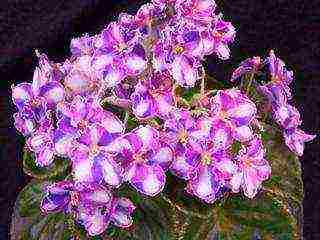 Their apex is slightly pointed, and the edges are wavy. The fleshy leaves are dark or light green in color. They are reddish, green or purple underneath. The plant has a lot of inflorescences, reaching 3-4 centimeters in diameter. Violet flowers are double, semi-double or simple. Their color is the most varied - from white to dark blue. There are varieties that have a two-tone color.
Their apex is slightly pointed, and the edges are wavy. The fleshy leaves are dark or light green in color. They are reddish, green or purple underneath. The plant has a lot of inflorescences, reaching 3-4 centimeters in diameter. Violet flowers are double, semi-double or simple. Their color is the most varied - from white to dark blue. There are varieties that have a two-tone color.
Hybrid varieties
The number of hybrids is many times greater than the main species. Thanks to selection, there are now about 2000 varieties and hybrid forms. Violets are classified according to the color and shape of the flowers and their type. Here you can distinguish star-shaped, classic, edged, fantasy and violets "chimeras". By the type of leaves, Saintpaulias are divided into boys and girls. At the base of the leaf of the "girls" there is a noticeable light spot, the "boys" have a completely green leaf. The size of the rosettes of these plants can be up to 60 centimeters. These are violets - giants. More often you see Saintpaulia with an average outlet (up to 40 centimeters). There are also miniature plants with rosettes up to 15 centimeters in diameter, and microminiatures up to 6 centimeters. Violets "chimeras" have a contrasting stripe on the petals. These are the most exotic varieties. They can only be propagated by stepchildren and peduncles. Each variety of violets is good in its own way.
The size of the rosettes of these plants can be up to 60 centimeters. These are violets - giants. More often you see Saintpaulia with an average outlet (up to 40 centimeters). There are also miniature plants with rosettes up to 15 centimeters in diameter, and microminiatures up to 6 centimeters. Violets "chimeras" have a contrasting stripe on the petals. These are the most exotic varieties. They can only be propagated by stepchildren and peduncles. Each variety of violets is good in its own way.
The most famous varieties
There are varieties of Saintpaulias that are in great demand among flower growers. They are common and are quite well adapted to domestic breeding conditions. Many hybrids were bred on their basis. We will consider the varieties of violets and a description of their features in more detail.
Dark Saintpaulia (Saintpaulia confusa) has a straight stem that reaches 10 centimeters in height. Its flowers are bluish-purple in color with yellow anthers and are collected in clusters of 4 pieces. Violet-flowered Saintpaulia (Saintpaulia ionantha) has a different color of inflorescences of bred hybrids: white, pink, blue, red and purple. Her leaves are green above and greenish-red below.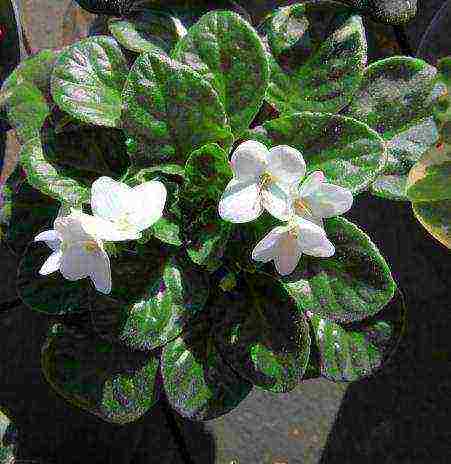 In its natural environment, this plant has only purple-blue flowers. Saintpaulia ionantha or Magungen Saintpaulia has branched stems that reach 15 centimeters in height. The leaves of this plant are about 6 centimeters in diameter and have wavy edges. Violet flowers are purple in color, collected in two or four in inflorescences. Saintpaulia teitensis is a rare protected violet species found only in Kenya. The best varieties of Uzambar violets are headed by Saintpaulia Chimera Monique, which has lilac flowers with a white border. Saintpaulia Chimera Myrthe is distinguished by pink-red petals, which are bordered by a white stripe. The violet Saintpaulia Ramona is a cultivar with dark red flowers with yellow anthers. And finally, the white violet Saintpaulia Nada, which is found in every lover of this plant. The varieties and names of store-bought violets may not be known. Real Saintpaulias with names are found only in specialized nurseries and are very expensive. Home-bred violets may have some mutations.
In its natural environment, this plant has only purple-blue flowers. Saintpaulia ionantha or Magungen Saintpaulia has branched stems that reach 15 centimeters in height. The leaves of this plant are about 6 centimeters in diameter and have wavy edges. Violet flowers are purple in color, collected in two or four in inflorescences. Saintpaulia teitensis is a rare protected violet species found only in Kenya. The best varieties of Uzambar violets are headed by Saintpaulia Chimera Monique, which has lilac flowers with a white border. Saintpaulia Chimera Myrthe is distinguished by pink-red petals, which are bordered by a white stripe. The violet Saintpaulia Ramona is a cultivar with dark red flowers with yellow anthers. And finally, the white violet Saintpaulia Nada, which is found in every lover of this plant. The varieties and names of store-bought violets may not be known. Real Saintpaulias with names are found only in specialized nurseries and are very expensive. Home-bred violets may have some mutations.
We buy violets
What should you look for when buying this plant? First of all, on the leaves. There should be no foreign stains on them. They may indicate that the plant is infected. Such a violet will be difficult to grow. For breeding from a leaf stalk, specimens from the second bottom row should be selected. The lower leaves can be severely depleted and produce fewer babies. Be sure to ask the seller about the variety name. The leaves of the plant should not be strongly extended upward. This indicates a lack of light. The socket must be healthy and free from decay. Violet cuttings and rosettes are very fragile. This must be taken into account when transporting them. The varieties and names of violets should be written and glued to the pot.
What violets love
Each flower requires its own breeding conditions. Regardless of which variety of violets you purchased, find a well-lit place for the plant. But remember that Saintpaulias do not like direct sunlight. From their contact, burns appear on the leaves, and with prolonged exposure to the sun, the flower may die. Violets, the photo and name of the variety of which can be found in this article, love windows on the west and east sides of the building. On the south side, they need to be protected from the sun by shading. The best temperature for comfortable breeding of violets ranges from 20 to 24 degrees. For a large number of violets, you can equip a special rack. The lighting in this case can be artificial. Saintpaulias do not like drafts, especially in winter. Therefore, this must be taken into account during long-term airing.
Watering violets
Any type of violet, white varieties or others, needs moderate watering. For this, it is better to use water at room temperature or slightly warmer. Standing or filtered tap water will do. It is better to water the saintpaulia in a tray. When irrigating from above, you need to try not to get on the leaves, flowers, and especially in the center of the outlet.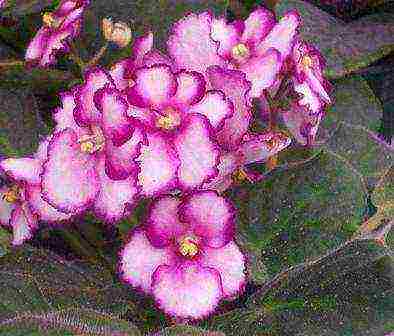 From this, spots appear on the flower, and it may die. After 10-15 minutes, pour out the water from the pan. The plant will absorb the required amount of moisture by this time. The soil of the flower should be moist and not very wet. If the environment is more moist, the rosette and root system will rot. Watering is carried out on average 1-2 times a week, but it depends on the season, soil quality and room temperature.Sometimes the violets are sprayed. This procedure will be useful in the summer. But it must be carried out with caution, do not allow the sun to hit the wet plant.
From this, spots appear on the flower, and it may die. After 10-15 minutes, pour out the water from the pan. The plant will absorb the required amount of moisture by this time. The soil of the flower should be moist and not very wet. If the environment is more moist, the rosette and root system will rot. Watering is carried out on average 1-2 times a week, but it depends on the season, soil quality and room temperature.Sometimes the violets are sprayed. This procedure will be useful in the summer. But it must be carried out with caution, do not allow the sun to hit the wet plant.
Plant feeding
Violets do not require frequent feeding. The finished substrate has all the necessary nutrients that are needed for the fruitful development of the plant. Therefore, it is enough to replant each variety of violets once a year or a little more often. To feed Saintpaulia, if it is depleted, use special fertilizers. They are both liquid and granular. Fertilizers should not be highly concentrated. The label must have the designation (NPK). Top dressing can be carried out no more than once a month. Remember that the earthen lump of the plant should not be overdried.
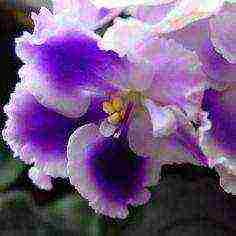 Be sure to read the instructions to properly feed the violet. For young rosettes, the nitrogen content in the soil should exceed the amount of potassium and phosphorus. In order for the plant to form buds and bloom profusely, it must be fed with phosphorus preparations. Then the flowers will be large and bright. Also during this period, Saintpaulia requires a lot of light. But fertilizer must be applied carefully. Excess nutrients can be harmful. Feed the plant if it really needs it. The unhealthy appearance of the violet may be due to improper care.
Be sure to read the instructions to properly feed the violet. For young rosettes, the nitrogen content in the soil should exceed the amount of potassium and phosphorus. In order for the plant to form buds and bloom profusely, it must be fed with phosphorus preparations. Then the flowers will be large and bright. Also during this period, Saintpaulia requires a lot of light. But fertilizer must be applied carefully. Excess nutrients can be harmful. Feed the plant if it really needs it. The unhealthy appearance of the violet may be due to improper care.
Reproduction of violets by leaf cuttings
Violet, new varieties of which appear quite often, reproduces well by leaf cuttings. But this does not apply to all species. Cuttings are the most affordable and easiest way to breed this beautiful flower. But, despite the simplicity of cultivating these flowers, many novice florists fail for the first time. The stalk rots and dies without rooting. Let's talk about some of the features of this process. Usually boiled water is used for rooting. Agroperlite or vermiculite is also used. The violet forms roots in sphagnum moss quite well. The latest achievement was peat-humus tablets, which minimize the risk of decay. To begin with, cut off the stalk with a sharp knife or razor. It must be taken from the middle rows. We do this carefully, since the violet is a very delicate plant. The petiole should not be too long. The optimal length is no more than 4 centimeters. Such a petiole will give large children much faster. We put it in the required substance. Air humidity for good rooting should be high, and the temperature within 20-24 degrees. It is better to build a small greenhouse on top, or put the container in a bag. Children should appear in a month or a month and a half. After they get stronger, you need to separate them. We do this very carefully, minimally damaging the root system. We put the kids in a separate pot. Each petiole that a violet gave (varieties, the photo is in this article) can form several shoots. The planting container should not be too large, no more than 6 centimeters in diameter. If the donor leaf remains strong, then it can be left for re-rooting.
Air humidity for good rooting should be high, and the temperature within 20-24 degrees. It is better to build a small greenhouse on top, or put the container in a bag. Children should appear in a month or a month and a half. After they get stronger, you need to separate them. We do this very carefully, minimally damaging the root system. We put the kids in a separate pot. Each petiole that a violet gave (varieties, the photo is in this article) can form several shoots. The planting container should not be too large, no more than 6 centimeters in diameter. If the donor leaf remains strong, then it can be left for re-rooting.
Landing kids
When planting, be sure to use drainage, which we put on the bottom of the pot. It can be sphagnum moss, polystyrene or small expanded clay. We choose a special soil for Saintpaulias. It should be loose, soft and nutritious. You can add vermiculite and perlite to it (one-fifth of the volume of the soil). You can also dilute the soil with sphagnum moss by cutting it into smaller pieces. For children, you can build a greenhouse for 2-3 weeks for adaptation. We put them on a lighted windowsill, but not on the south side. In winter, drafts must be excluded so that the root system does not overcool. After 2-3 weeks, you need to start hardening the plants by opening the greenhouse. You need to start with 15 minutes and bring the time to 30 minutes.
Reproduction by stepchildren
Violets, the photo and name of the variety of which are mentioned in this article, are propagated by stepchildren. For rooting to be successful, you need to wait for 3-4 leaves to appear in the stepson. You will need a scalpel or awl for this procedure. With their help, the stepson is carefully separated from the mother plant. It is necessary to injure the roots of both Saintpaulias and leafy cuttings as little as possible. Now you need to carry out the rooting procedure. To do this, use a pot with a substrate or a peat-humus tablet. Then the stepson is transplanted into a pot of earth and a greenhouse is made over it. After 3-4 weeks, it is necessary to start hardening, gradually removing the greenhouse. This breeding method is ideal for chimera violets and fantasy varieties.
Choosing pots
Choosing the right container for planting violets is very important. The main thing here is the diameter. Its value for young outlets and children should be 5-6 centimeters. Older plants are planted in pots with a diameter of 10-12 centimeters. It is believed that a good pot should be three times smaller than the outlet itself. The height of the pots should not be large. Violets look very nice in low containers. Both ceramic and plastic pots can be used. The second type is more affordable.
Violet care
These many-sided flowers, pink violets - varieties with delicate flowers, white - pure and innocent, red - passionate, blue - bewitching, in need of anxious care. In adult plants, it is imperative to remove old leaves that lose color and spoil the look. After removing the bottom row of leaves, add soil to the pot or cover it with sphagnum moss. With proper care, the plants will delight with their magnificent flowering, and their cultivation will only bring pleasure. Provide the Saintpaulias with good lighting, a comfortable temperature, sufficient humidity and watering, and, most importantly, love, and they will reciprocate. There are so many varieties and varieties that you can start collecting them by adding new, exquisite types of violets.
As a result of the painstaking work of scientists the classic violet with blue flowers became the progenitor for a large number of new varieties... Violets are distinguished by a variety of shapes and shades. Double or semi-double flowers appeared. The colors have mixed with each other, now on the windowsills of avid collectors you can contemplate violets with patterns, spots, stains, blotches, stripes and contrasting borders. What are violets? Let's take a closer look at the most popular varietal violets described in this article.
Types and varieties of Saintpaulia, a description of a houseplant
All violets were divided into several groups to facilitate orientation among the many species. There are three groups:
- collectible;
- variegated;
- industrial.
Variegated varieties are characterized by the brightest color of the leaves, which can be painted in different colors... They often have a border at the edges. The first variegated varieties bloomed small and uncomplicated sotsveia, but later breeders bred species that were distinguished by large double flowers of different colors.
 Industrial dutch violet
Industrial dutch violet
Industrial - designed for mass cultivation on special plantations... They are available for purchase in large quantities. Their appearance is the simplest. Basically, these plants are used to decorate banquet halls, they are placed in offices and government agencies. These varieties bloom actively for a long time.
They require minimal maintenance, so they are often grown at home.
Collectible
They are characterized by large inflorescences ranging in size from five to seven centimeters. They differ from others in that they are almostthey have large wavy double petals, painted in the widest range of colors: from pure white to deep blue shades.The leaves are also of different colors and have wavy edges.
Violets of these varieties are collected by collectors and shown at exhibitions.
The most beautiful and unusual varieties are collected at exhibitions. Difficult collectible varieties require more time and effort to grow successfully and care properly. Labor is rewarded with gorgeous flowering. Collectible violets include: Lemon Snow, Willodene, Gift for a loved one and many more.
Name difference
Saintpaulia and Uzambara violet are the names of the same plant that is cultivated at home. Saintpaulia is a Latin scientific name, and the Uzambara violet is a folk... People began to call Saintpaulia the Uzambara violet, because in its natural environment the plant is found in the Uzambar mountains.
Viola - Latin name for violets, which are grown in gardens.
Purple
Currant dessert
Currant dessert
They take the form of stars, they are very fluffy and semi-double. Fringe of an unusual color stretches along the edges of the petals: it resembles the shade of blackcurrant jam. The velvety leaves are colored green. The variety is quite unpretentious, suitable for beginners.
Winter rose
Violet Winter Rose
In shape, the flowers strongly resemble pink inflorescences, which is why the variety bears this name. The petals are dark blue-violet. A thin snow-white edging runs along the edges... Small leaves are colored deep green. Winter rose conveys the quality of the variety well.
Baltika
Violet Baltic
The jagged-topped leaves form a compact rosette in a bright green hue. They are semi-double. They grow to impressive sizes and turn blue-violet. There is a wide, blurry white border around the edges..
White
Alice Blizzard Bani (Aly's Blizzard Bunny)
Violet Alice Blizzard Baths
Snow-white flowers are small in size and shape strongly resemble stars. The variety belongs to semi-double... The leaves, which take the shape of a heart, are painted in a rich green color. This type is very popular among amateur flower growers.
Snow lace
Violet Snow Lace
The variety is characterized by lush terry flowers of a snow-white shade. There is a bluish speck in the center... The edging of the petals shines with a barely noticeable greenish tint. It blooms very actively and luxuriantly. The leaves are light green.
The bride's bouquet
Violet Bridal Bouquet
It was bred by the Russian breeder Konstantin Morev. Large flowers of delicate white color in the shape of a star with wavy edges are very similar to a wedding bouquet... Blooms profusely. The petals are even in color, there are no blotches and patterns.
Pink
Georgia
Violet Georgia
A variety of fabulous beauty. Large double flowers consist of deep pink petals, along the edges of which lilac blotches are scattered... The wavy edges of the petals are decorated with a thin light green border. Flowers bloom on powerful peduncles. It blooms profusely, subject to the necessary conditions.
Marquise
Violet Marquis
The variety was bred in 2011. Dissolves large double flowers in a rich pink shade... A lilac border with the thinnest snow-white line runs along the edge of the petals. The leaves are dark green. Looks great on the windowsill.
Magdalene
Violet Magdalene
The foliage is colored green. In the middle of the rosette there are large double flowers that resemble a ball. The petals have a wavy edging. Flowers are located very close to each other, which gives the impression of a huge bouquet... Very popular at exhibitions. Many people acquire a leaf of this variety.
Lilac
Lilac beauty
Violet Lilac charm
The variety is distinguished by large purple flowers with specks of rich lilac in the center. There is a dark border on the edge of the petals. The flower stalks are powerful, the rosette of the correct shape consists of round leaves... This variety is easy to care for and is suitable for beginners and even children.
Favorite daughter
Violet Favorite daughter
Flowers are rich lilac color with a border, painted in dark purple. Leaves with teeth are rounded and colored in emerald color... The reverse side has a distinct crimson tint. Flowers are born small and dark. As they develop, they brighten. It can lift up the leaves, so it needs a lot of space on the windowsill. Beautiful and lush flowering almost constantly pleases the grower. They bloom for two to three weeks.
Blue
Blue dragon (Blue Dragon)
Violet Blue Dragon
A well-known variety of the Sorano selection. Almost all collectors have this variety. Popular for its large flowers in a delicate blue color... A greenish-white border stretches along the edges of the petals. The variety is quite moody. It needs a natural light source and cannot tolerate farming mistakes.
Blue Danube
Violet Blue Danube
Bred by Russian breeders. It is characterized by large flowers that are up to five centimeters in size. The petals are pale blue. Matte leaves with wavy edges at the end have small teeth... This variety needs good lighting and proper watering. The abundance and duration of flowering depends on the temperature.
Blue Lagoon
Violet Blue Lagoon
The variety is characterized by large, semi-double, deep blue, star-shaped flowers. It has a blue spot in the center and a purple border around the edges. When there is not enough light, it lifts the leaves up... The flowering period is two months. Unpretentious in care, even a beginner can grow.
Variegated
Lemon Snow
Violet Lemon Snow
The flowers are painted in snow-white color with lemon-colored rays. The middle and edges have a bluish tint. Leaves are variegated, painted in a rich green color... A white border runs along the edge of the leaf.
Willodene
Violet Willodene
A variety with unusually beautiful variegated leaves. Peach flowers with a greenish edging are not the main charm. At exhibitions, attention is paid to wavy leaves, painted in emerald colordiluted with pink and white spots.
Gift for a loved one
Violet Gift for a loved one
Leaves of deep green color with sharp tips and edging in a pink-white hue are of particular value.... The flowers are blue. A purple border runs along the edge. It enjoys great success at exhibitions. Quite an unpretentious variety.
Ampelny
Ampel violets are used for growing in hanging pots. They decorate hanging flower beds and gardens. They have several points of growth, long stems hanging down, and a large number of lateral shoots. The most popular varieties of ampel violets - Trinket Summer Skyes with rounded green leaves and blue flowers and Robs Humpty Doo with light leaves and snow-white flowers.
They need a lot of light. They are able to bloom for a whole year.... In winter, the plant is provided with additional lighting.
Mini varieties
The rosette of miniature violets does not exceed fifteen centimeters in size... At the moment, about two thousand varieties of mini-violets are known.
Mini violets are very popular among flower growers.
Many collectors only collect miniature violets. Caring for miniature violets has some features: they are less whimsical than big brothers.
Among mini-varieties can be distinguished Avatar with simple semi-double flowers of a pale blue hue and variegated leaves. Attracts florists and is gentle a variety called my angel... Simple flowers on powerful peduncles are tinted pink. Leaves of pale green color are distinguished by a wide edging of snow-white color.
What varieties are cultivated at home?
At home, they grow simple violets of the industrial group, variegated and collectible. Beginners are advised to start simple violets to gain experience in grooming. An experienced florist can already grow complex breeding varieties. A huge number of species are grown at home. Experts have bred about thirty-two thousand varieties of indoor Saintpaulias, differing in many ways.: color, shape, structure of leaves and rosettes.
In the wild, there are about twenty species of Saintpaulia. In natural conditions, there are:
Velvet Saintpaulia
Velvet Saintpaulia
On the front side, the leaves are colored green, and the reverse side has a reddish tint... The inflorescence is collected from purple flowers with a dark central part.
Violet Saintpaulia
Violet Saintpaulia
Blue-violet flowers bloom on short stems and rich green, heart-shaped leaves grow. The rosette diameter can be up to sixty centimeters.
Saintpaulia Grotte
Saintpaulia Grotte
Refers to ampel varieties. The pubescent leaves take on a rounded shape... Lilac-blue flowers do not grow more than two and a half centimeters.
Useful properties of violets
Indoor violet can not only please the eyes of the grower, but also help with various diseases. It has a beneficial effect on the body in case of renal inflammation, bronchitis, joint pain and atherosclerosis.... A decoction is prepared from a Saintpaulia leaf filled with boiling water, which is added to tea. Take it during the day. You can bathe children in violet broth. This method will help heal scrofula, rickets, eczema, and skin rashes. Violet tinctures help with tinnitus after childbirth. With the help of a violet leaf, you can get rid of insomnia and neuroses.
Before taking a medicinal broth, you should definitely consult your doctor.
The plant contains poisonous substances that, if used incorrectly, poison the body... There is a month break between courses.
It is difficult to single out the very best Saintpaulia varieties, provided there is a huge variety. The most beautiful are certainly the collectible varieties.... The most popular among florists are - Winter parasol, Adonis, Rococo Pink and many others.
Indoor violet (Latin Saintpaulia) came from the genus Saintpaulia, the Gesneriev family. This plant was identified as a separate genus by the scientist Hermann Wendland. which gave her the name Saintpaulia. It resembles a real violet (Viola), and therefore the plant is called the Usambar or African violet by the place of origin of the flower.
Indoor violet - description
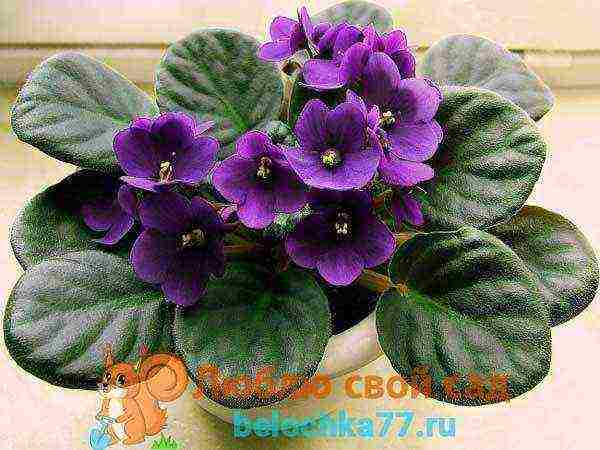
Indoor violet belongs to perennial herbaceous plants. She has an underdeveloped fibrous root system and fleshy stems. Depending on the species, the stems can be short, with leaves growing at the roots and forming a rosette, or elongated, branching with a large number of hanging rosettes. The stem diameter can be from 6 to 60 centimeters long.
The leaves are round, elongated or ovoid. The base is heart-shaped or simple. The tip is rounded or sharp. The edges are light, slightly rounded or coarsely serrated. The leaves are flat, strongly corrugated, slightly wavy or curved to one side or the other.
The leaves are green in color, sometimes with silvery or golden hues. Sometimes there are cream, olive, lettuce, yellow or pink patches on the leaves. Multi-colored areas are located at the edges of the sheet, at the base, or form a variety of patterns. The inner side of the leaf is most often silvery-green, sometimes it has a red tint.
Types and varieties of violets with photos, names, descriptions
Violet has become the ancestor of many varieties. Their distinctive feature is the shape and shades of colors. Semi-double and terry varieties were bred. The colors are mixed. Now you can see violets with spots, stains, contrasting edges, patterns, stripes and splashes.
Semi-double violet
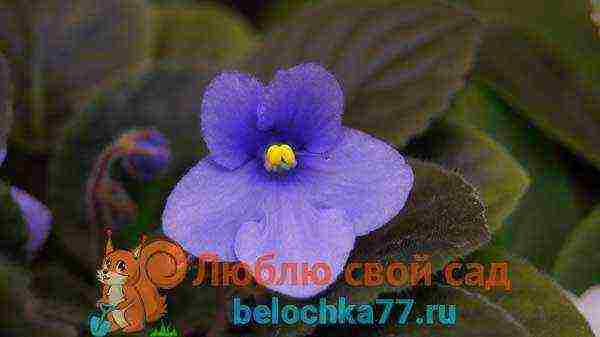 Semi-double violet
Semi-double violet
The petals are covered with very small shiny balls. Sometimes there are species covered with soft fluff. Such violets are called velvet. The edge of the petal is strongly corrugated or slightly wavy.
Terry violet

Flowers form voluminous cluster-like inflorescences. The diameter of the flowers ranges from 2.5 to 9 centimeters. The color of the petals can be white, blue, purple, purple and other shades.
Indoor violet varieties are divided into 3 groups:
- variegated;
- collectible;
- industrial.
Variegated violets have a bright color of the leaves. They are painted in various colors. Border often stands out well. Breeders have bred species that have large double flowers of different colors.
Collectible violets characterized by voluminous inflorescences up to 7 centimeters in size. They have large double wavy petals. The color is different, from snow-white to deep blue shades. Leaves with wavy edges have different colors.
Industrial violets intended for mass cultivation. They are not demanding to care for.
Depending on the location of the petals, the size of the flower, violets are divided into 5 types:
- star;
- pansies;
- bowl;
- bell;
- wasp.
Violet Star
Violets of this species have the same petal size. They are evenly spaced around the core.
The beauty queen
 Variety Goddess of Beauty
Variety Goddess of Beauty
The inflorescences form double bright pink stars with a purple-violet tint. Large basal bush. Leaves are dark green in color.
Marshmallow
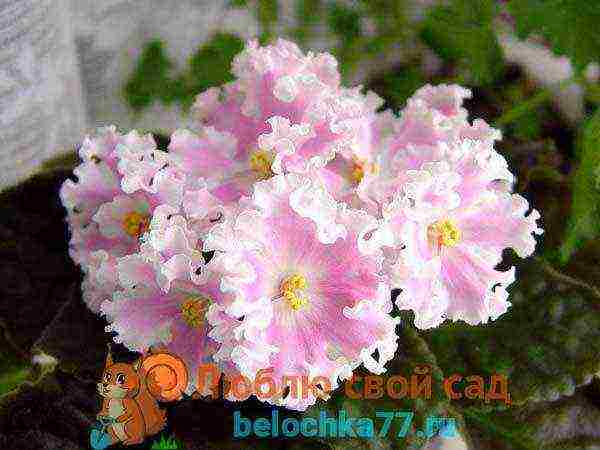 Zephyr variety
Zephyr variety
Large, creamy white, semi-double or double buds with coral or pink strokes on the surface. The edges are wavy. Peduncles are large, erect. The leaves are light green. The outlet is large, but compact. The plant grows quickly. At elevated temperatures, it can bloom with simple white flowers. When watering, water should not fall on the leaves.
Pauline Viardot
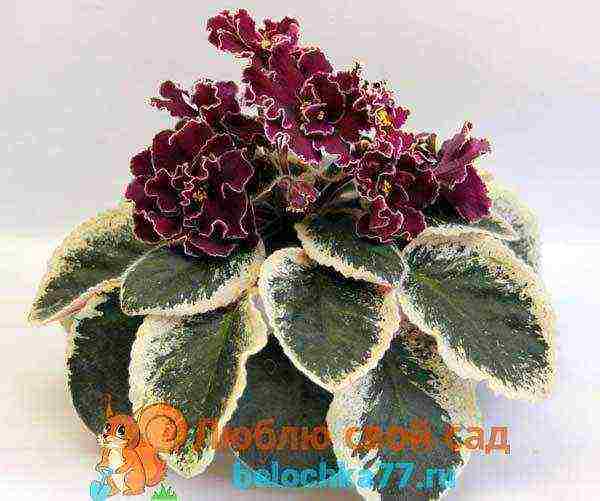 Pauline Viardot variety
Pauline Viardot variety
The flowers are large, simple or semi-double, painted in a wine shade. The edge is bordered with a thin white ruffle. Flowers are arranged vertically. The variegated rosette is compact, bright.
Black Pearl
 Variety Black Pearl
Variety Black Pearl
Flowers are large, densely double. The velvet color surprises with the overflow of purple and violet tones. The socket is standard. The leaves are oval, dark green. Petioles are long, strong.
Bullfight
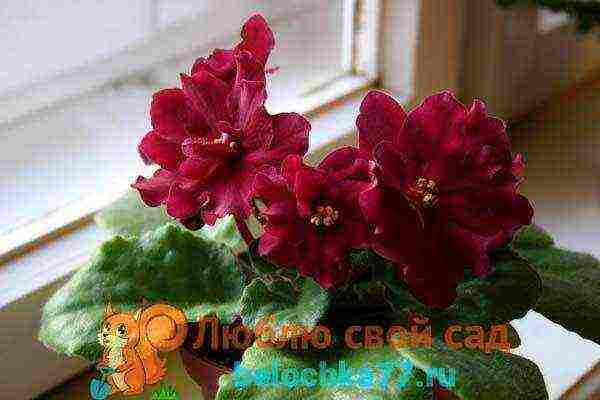 Variety Bullfight
Variety Bullfight
The flowers are very large, with a diameter equal to 8 centimeters. The shape of the flowers is semi-double or double. The color is thick burgundy. Leaves are light green, pointed at the ends.
Beautiful creole
 Variety Lovely Creole
Variety Lovely Creole
It is a prolific and undemanding resistant variety with velvety flowers. Violet blooms often and for a long time. The compact small outlet contains a variety of simple dark blue, velvety colors. The buds are large, 5 centimeters in diameter. The edges have a white border that sometimes turns light green. The stem is burgundy, strong.
Cinderella's Dream
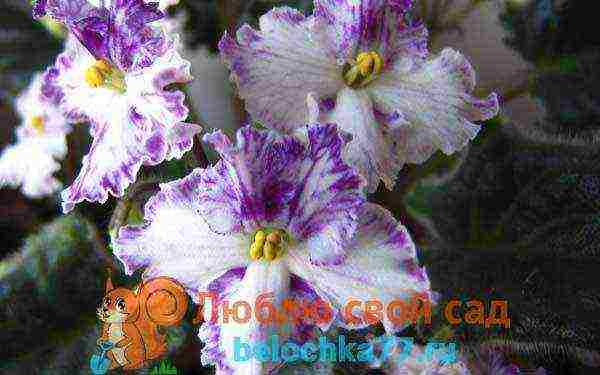 Variety Cinderella's Dream
Variety Cinderella's Dream
The flowers are semi-double, large, lacy, light purple with a raspberry tint. The petals are covered with a purple-violet pattern. The upper petals are darker, small in size. Fringed edges, greenish. The border is corrugated, purple along the edge of the petal. The socket is flat. The leaves are wavy, dark, evenly colored.
Viscount
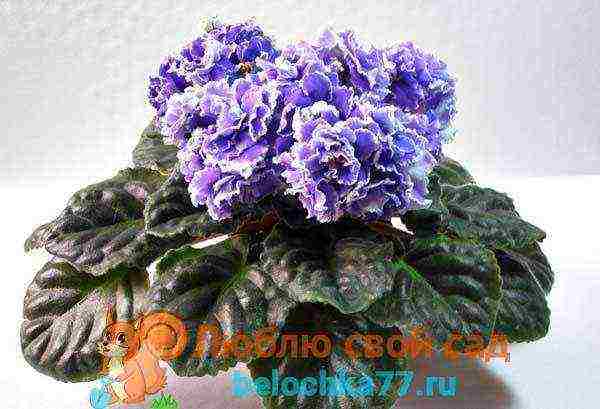 Variety Viscount
Variety Viscount
The flowers are blue, wavy, large, double or semi-double. Edges with corrugated wide white border. Quilted leaves, dark green. The socket is simple.
Magenta
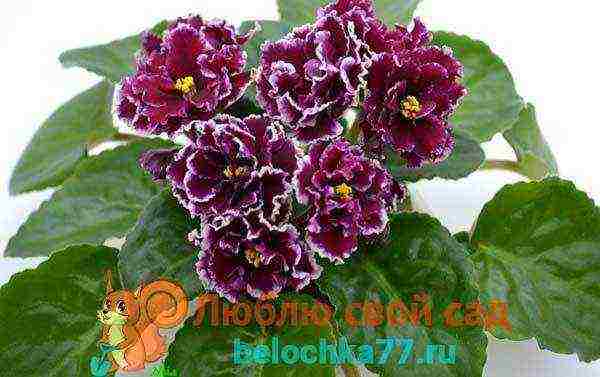 Magenta variety
Magenta variety
Flowers are semi-double or double, rather large. The color is saturated, red-burgundy.The edges have a discontinuous white wavy border. The socket is small. The leaves are pointed at the ends, light green in color.
Black Prince
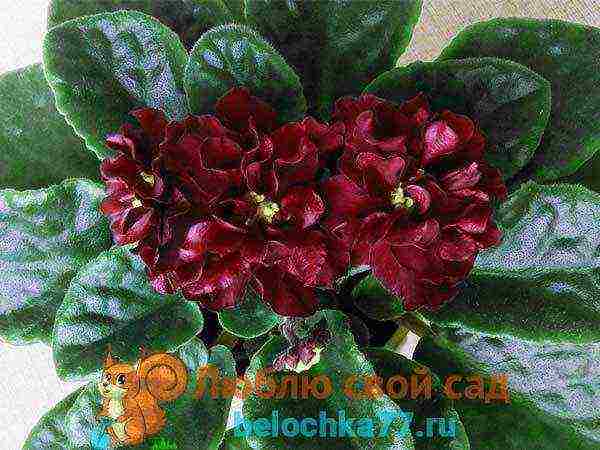 Variety Black Prince
Variety Black Prince
Large black-red double flowers. The foliage is dark green. The wrong side is red. The size of the bush is standard.
Blue fog
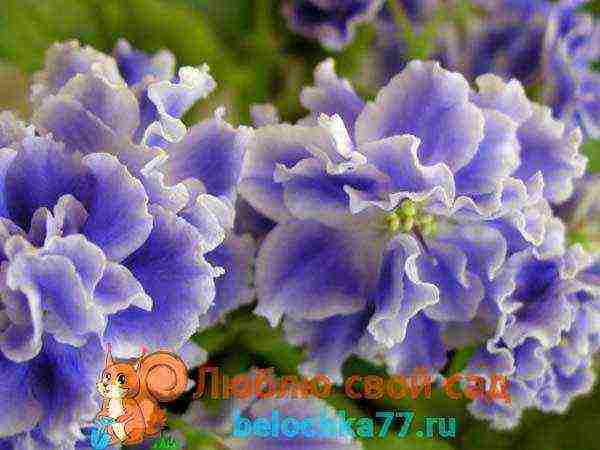 Variety Blue Mist
Variety Blue Mist
It is a standard variety with double, rather large blue buds. The edges of the buds are decorated with a white border. The stem is shortened. Medium leaf rosette. Leaves are long-petiolate, dark green in color, rounded. The edges are wavy.
Winter smiles
 Variety Winter smiles
Variety Winter smiles
The variety is unpretentious, semi-double, lush and abundantly blooming. The flowers are pink. The edges are crimson with light green or yellowish green fringes. The petals reach 6 centimeters. Fringe turns white at high temperatures. It becomes more noticeable when the plant is grown in a cool room. Green leaves with olive tint, slightly elongated, embossed, quilted. The rosette is flat, medium-sized, growing up to 35-40 centimeters.
Violet Pansies
This species has a 5-petal bud. The size of the upper two is smaller than that of the lower three petals.
Spring outbreak
 Variety Spring Flash
Variety Spring Flash
Early variety, blooms for a long time. The flowers are velvety. The petals inside the flower are bright yellow, the outer ones are burgundy-brown. Some flowers are completely burgundy or yellow. The variety is suitable for ampel cultivation.
Heavenly queen
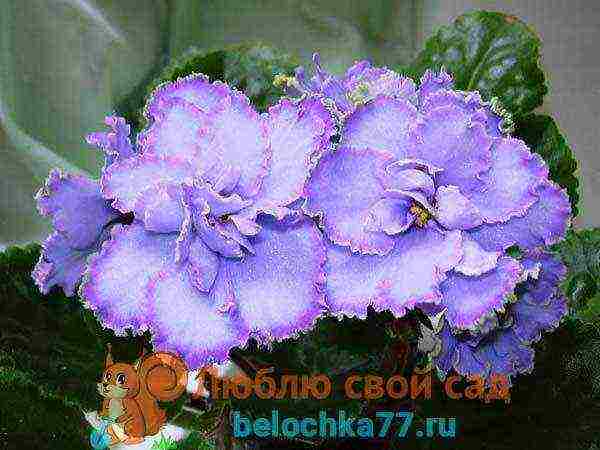 Variety Heavenly Queen
Variety Heavenly Queen
The bright blue flowers turn lilac over time. The edge of the petal is pink.
Violet Bowl
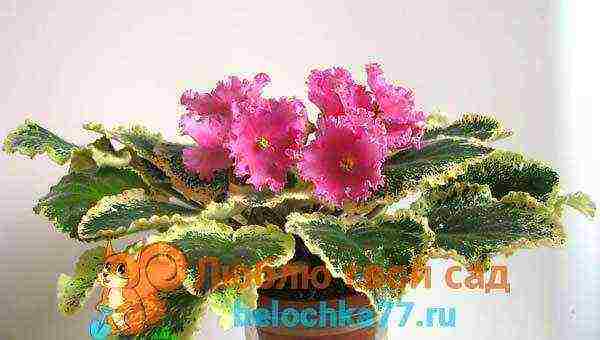 Variety Bowl
Variety Bowl
These violets have petals that have not grown together at the base. The bud does not fully open, retaining its shape throughout the entire flowering.
Violet Boo Man
 Boo Man variety
Boo Man variety
Flowers can be double or semi-double. The color is sky blue. The upper petals are white. The diameter is small, reaching 3 centimeters. Leaves are oval, deep green.
Ming dynasty
 Variety Ming Dynasty
Variety Ming Dynasty
The variety is distinguished by a bowl-shaped shape. The petals are white. The edges are slightly corrugated, pale pink in color. Leaves are bright green, variegated, wavy edges.
Violet Bell
The bell violet has petals fused at the base. The flower is like a bell, it cannot fully open.
Shining bell
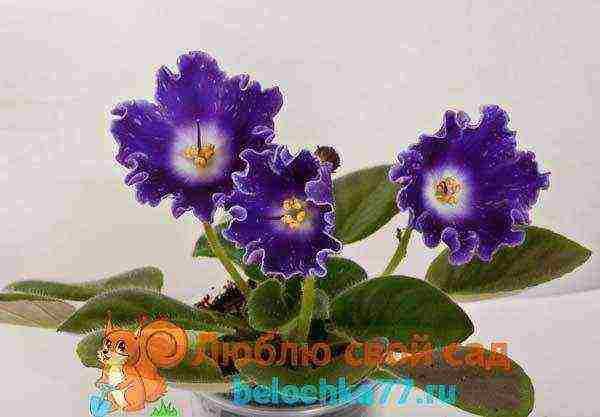 Variety Shining Bell
Variety Shining Bell
The variety develops flowers in the form of blue bells. The edges are wavy. They show rare touches of fantasy. The eye is bright yellow. Leaves are green in color. The rosette is of the correct shape.
Sea wolf
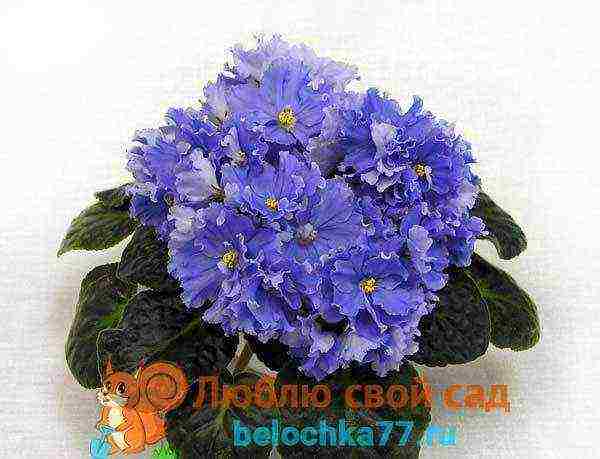 Variety Sea wolf
Variety Sea wolf
This is a semi-double variety. The flowers are blue, large, up to 8 centimeters in diameter. The edges are wavy. The petals are wavy, with a mesh pattern, which is clearly visible after the bud is completely dissolved. The leaves are drooping, dark green, fleshy, large.
Chanson
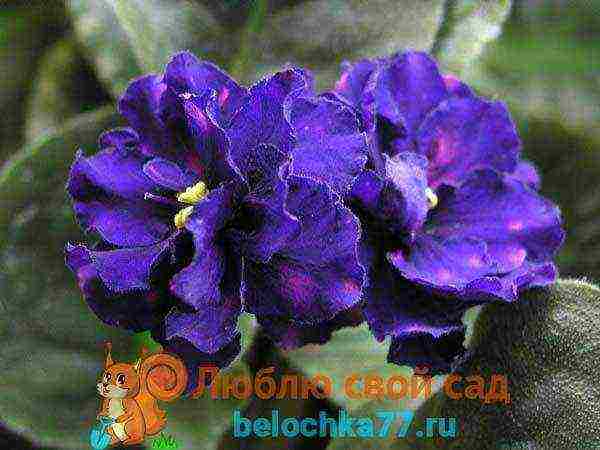 Chanson variety
Chanson variety
It is an unpretentious, abundantly and long-blooming terry variety with bell-like flowers. The flower consists of a huge number of purple-purple or dark blue velvety petals, playing in the light in different shades. Wavy petals slightly shade light or dark pink spots. The leaves are shiny, smooth, dark green. The rosette is symmetrical, large.
Violet Wasp
In this violet species, the petals are completely separated. Two are rolled up into a tube, and three elongated hang down.
Saintpaulia Blue Teil Fly
 Blue Teill Fly variety
Blue Teill Fly variety
The flowers are bright blue. The upper petals are tubular, the lower ones are elongated. The leaves are fleecy, rolled into small bags.
Zemfira
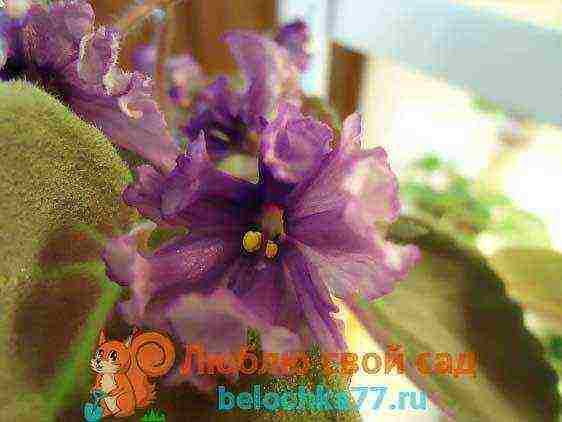 Zemfira variety
Zemfira variety
Tubular flowers are simple or semi-double, lilac in color. Corrugated edges. Medium socket. Leaves are green, variegated in the center.
Varieties of violets that cannot be classified are divided into types: Chimeras, Mini, Retro, Variegated, Ampelny, white, pink, purple.
Chimeras
This violet is a subspecies. She combined several varieties of Saintpaulias.The petals of this violet have 2 genetic layers with different colors. The background is colored by the main cells, and the top layer of cells is depicted as a spot, a clear stripe. The plant combines 3 types of flowers with different genetic characteristics. Violet is endowed with a wide range of colors. Its coloration is divided into 2 main types:
- straight;
- back.
In the first case, the petals are lighter than the strip in the center. In the second case, the base is darker than the strip or spot in the center.
There are also chimeras that do not fit the description of these types, these are leafy violets. Their flower can be one-color, and the foliage is painted with intricate patterns.
Dance of the Galaxies
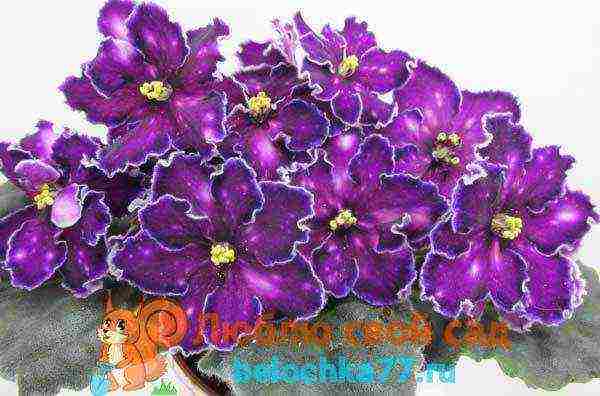 Variety Dance of the Galaxies
Variety Dance of the Galaxies
Flowers-stars are large, bright purple. The edges of the petals are darkened, have a thin white border. The petals are decorated with frequent white fantasy polka dots. Quilted leaves, dark green. The seamy side is red. The socket is standard.
Firebird
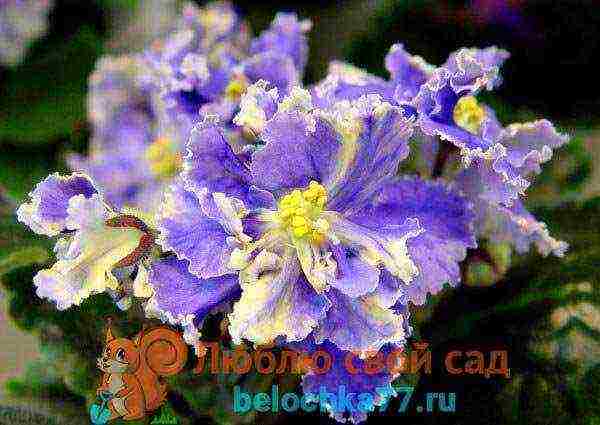 Firebird variety
Firebird variety
Semi-double light blue corollas have bright large yellow strokes. The petals are corrugated, uneven. The rosette consists of wavy green leaves.
Yesenia
 Yesenia variety
Yesenia variety
Flowers are semi-double, large, white. Violet tint prints are visible on the petals. The edge is framed with a greenish white lace border. The socket is small. Leaves are emerald green.
Stasis
 Variety Stassia
Variety Stassia
The variety is abundantly flowering. Smoky cherry smears are clearly visible on large semi-double flowers. The edge is wavy, slightly outlined, green. The socket is compact.
Raisin
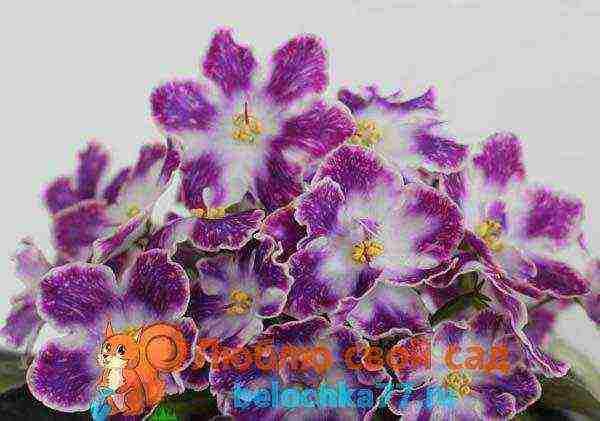 Raisin variety
Raisin variety
Lavender flowers with white dots on slightly ruffled petals. Blotches sometimes fill most of the petals. A wide white border runs along the edge. A crimson strip is visible on the border of the border. The eye is white. The compact rosette consists of medium green, small leaves.
Peacock
 Peacock variety
Peacock variety
White large flowers are simple or semi-double. The petals are wavy, with blue patterns and prints and a coral color. The rosette is flat, with green foliage. Abundant flowering occurs under artificial light.
Isadora
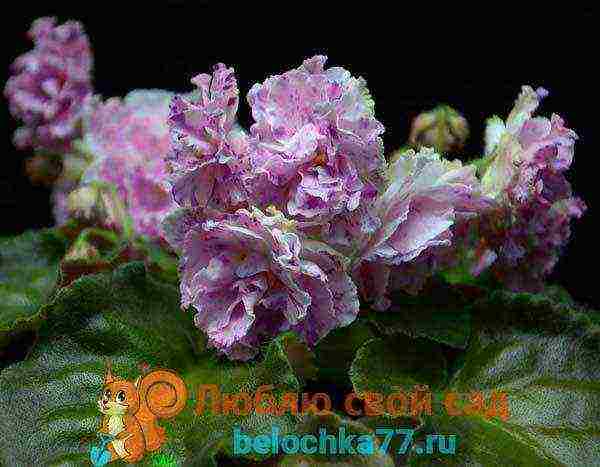 Isadora variety
Isadora variety
Snow-white flowers are very large, semi-double. Pink specks are scattered on them in abundance. The leaves are voluminous, dark green. Peduncles often bend under the weight of the buds.
Jan minuet
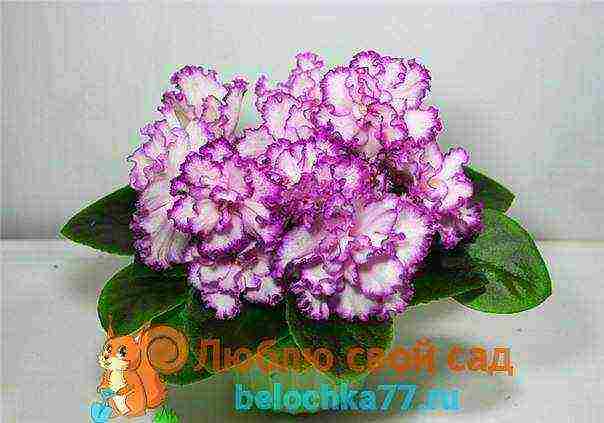 Jan minuet variety
Jan minuet variety
Large double flowers. They resemble stars. Their diameter is 7 centimeters. The color is pale pink, densely sprayed with a thicker shade. The border is crimson, corrugated, the width varies. The flowers show bright color transitions. The petals are wavy, large. The peduncle is strong, high. A round bunch of 3 flowers, similar to pompons, is formed on one peduncle. The foliage is slightly wavy, dark green, jagged edges. The socket is standard, small.
Ice rose
 Ice rose variety
Ice rose variety
The variety attracts attention with its bright color of petals. The flowers are like noble roses. With each new bloom, the hue and structure of the colors change. The inner part of the white petals eventually turns cherry or lilac, and the border of the petals turns light green. White petals have lilac or crimson-pink strokes. The edges are corrugated, light green or pale yellow in color. During the flowering period, 6-7 flowers are formed. The foliage is large, dark green. The edge is slightly wavy. The socket is large.
Rosemary
 Rosemary variety
Rosemary variety
It is a long-flowering, high-yield variety in standard sizes. Flowers are large, double. The background of the petals is white. It can be seen along the edges and at the base of the petals. Above the background is a soft pink color and blue or purple splashes. The amount of splash on the petals may vary. Due to the abundance of petals, the violet looks like a pompom. The edge of the petals is curved, wavy. The rosette consists of serrated, dark green leaves.
Mini
The rosette of these violets is small, no more than 20-25 centimeters in size.Today, about 2 thousand varieties of these miniature violets are known. They are less whimsical than other larger varieties.
Aquamarine
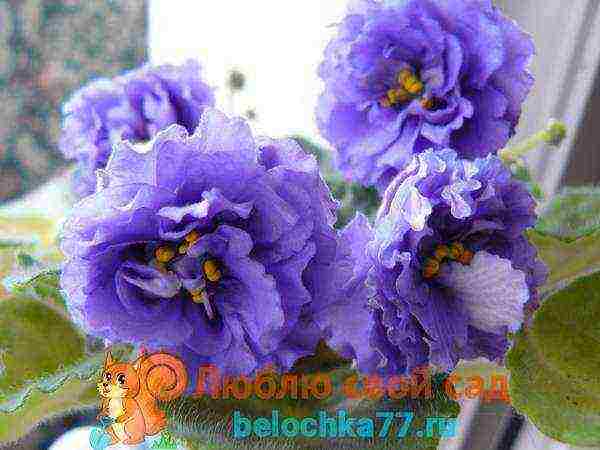 Aquamarine variety
Aquamarine variety
The variety is abundant and blooms for a long time. Flowers are rounded, double. The petals are white with blue streaks. Outside, the inflorescence is green. The leaves are green. The rosette is compact, 20-25 centimeters in diameter.
Oksana
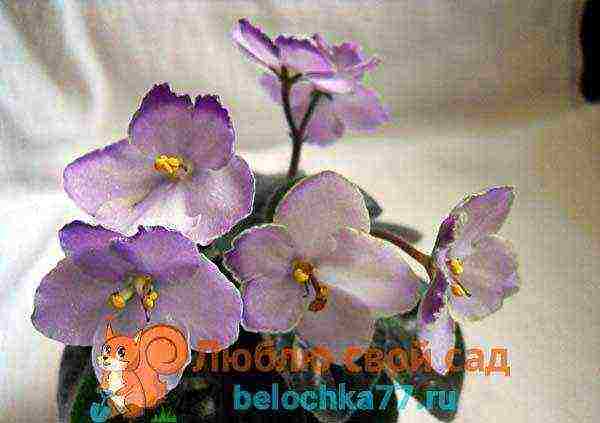 Variety Oksana
Variety Oksana
Variety of violets with semi-double large lavender flowers. The tips of the upper petals have a dark border. The leaves are dark green. The variety belongs to semi-mini violets.
Maria
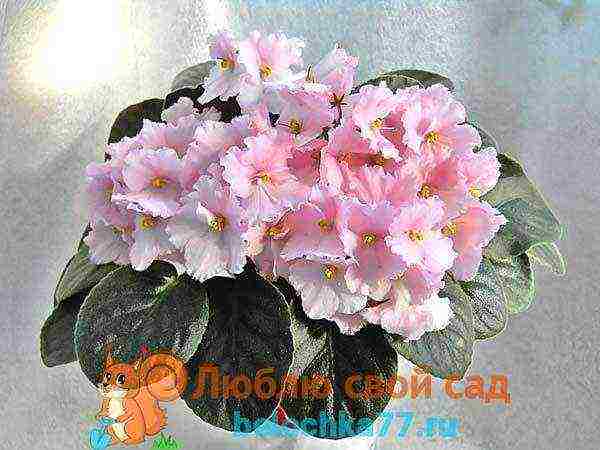 Variety Maria
Variety Maria
Variety with large, double corollas with bright pink flowers. The flower resembles a miniature rose. A purple pattern covers each petal. The edges of the flowers look like ruffled ruffles. The rosette is deep green.
Retro
It is a sprawling, dense, fast-growing and unpretentious violet. The plant blooms often and for a long time.
Lilac flowers are bizarrely combined with light green and white. The petals are covered with an unusual vein-like pattern. Veins are clearly visible on the stem, of which there are up to 8 pieces.
Angelica
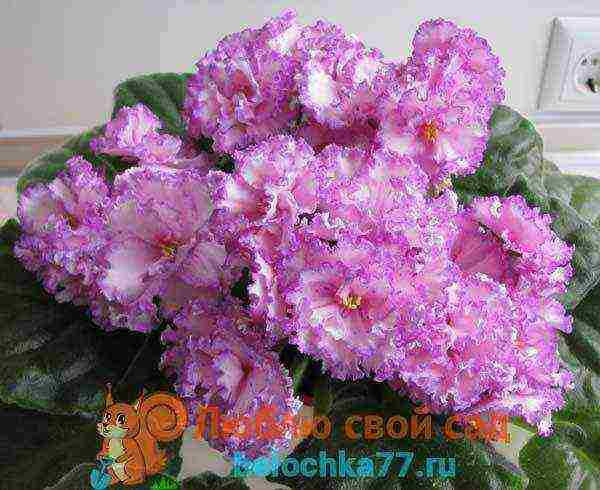 Angelica variety
Angelica variety
This mini-variety has large double light pink or dark cherry flowers with a coral core. The main highlight of the variety is the double edging of the petals. Leaves are deep green. Closer to the center of the flower is a strip of lilac splashes. Corrugated edge painted pure white.
Amadeus
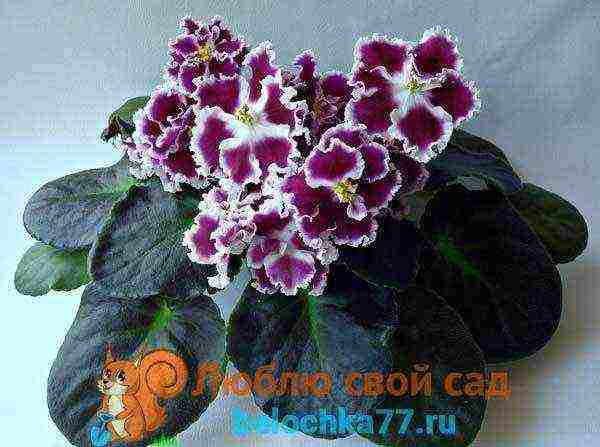 Amadeus variety
Amadeus variety
The variety has large red-crimson velvety double or semi-double flowers. Petals are oblong. They reach 5.5-6 centimeters in diameter. Corrugated edges. The border is thin, white. In the middle of the flower, a white tint is visible. Flowers are collected in compact inflorescences. As the flowers dissolve, the color of the petals becomes brighter. The rosette is large, reaching 40 centimeters in diameter. Leaves are simple, large, light, almost olive, with long petioles.
Olesya
 Variety Olesya
Variety Olesya
Semi-double flowers are velvety, large. The color is deep, pink-burgundy. The socket is small. The leaves are medium-sized, dark green.
Frosty cherry
 Variety Frosty cherry
Variety Frosty cherry
The double flowers of this variety are large and very beautiful. The diameter of the flower reaches 4 centimeters. They do not become so immediately, but gradually. At the first flowering, the size of the flower is much smaller. In subsequent years, the size increases each time. The main color of the petals is cherry red. The border is wide and white. In the center of each petal is a large fuchsia spot.
Esmeralda
 Esmeralda variety
Esmeralda variety
The variety has large velvety leaves. The flower is burgundy-crimson, double or semi-double. The edges are slightly darkened, the corrugated border is white-green. The border of the blossoming flower is green. At a cool temperature of the content, the color remains, and in a warm room it gradually turns white. The violet blooms with a luxurious hat.
Chateau Brion
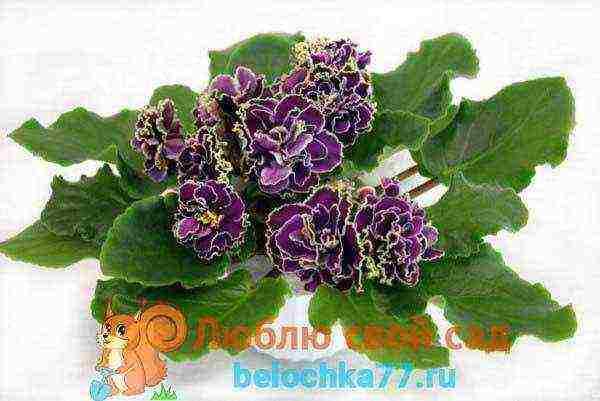 Chateau Brion variety
Chateau Brion variety
Peduncles are upright, powerful. Flowers are similar to pompons, large, double, wine shade. The edge of the petals is decorated with a wide, corrugated white border. The socket is standard. Leaves are slightly wavy, oblong-ovoid.
Violets - home care
Variegated
There are 3 types of variegation. The most beautiful view is with bordering variegation. In such plants, light areas are evenly distributed along the contour of the foliage.
The color of variegation can be white, cream, white-pink, brown, grayish-pink, less often yellow, dark pink. The intensity of the variegated color depends on the conditions of the plant and the air temperature. In a cool and well-lit room, the flower becomes brighter. With a lack of light, the leaves become greener, the variegation in some cases disappears completely (during flowering). By inheritance, the color is transmitted rather poorly.
With crown variegation, the center of the rosettes is colored golden, pink and white. This species is more stable, it is inherited.
Rows of green foliage alternate with colored foliage. During the flowering period, in most varieties, the center of the rosettes turns green.
Mosaic variegation is a more stable species. The foliage of such violets is partially or completely covered with an irregular intricate pattern, similar to the pattern on marble or a mosaic of cream, pink, strokes and spots. This type of violet is quite rare.
Another species is known, this is spontaneous variegation. These plants do not transmit variegation from parent varieties.
Summer twilight
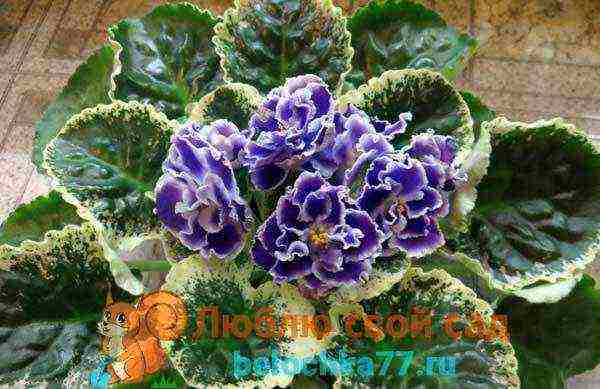 Variety Summer twilight
Variety Summer twilight
The flower is in the correct proportions. The flowering is quite abundant. Inflorescences are large, semi-double, contrasting. The background color of the petals is lilac-violet. The edges are trimmed with white ruffle. Leaves are variegated, slightly concave. The edges are slightly wavy. The rosette is flat, spherical.
Blue dragon
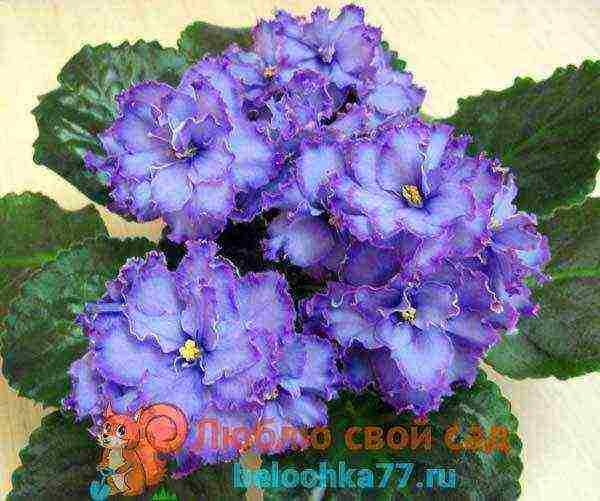 Blue dragon variety
Blue dragon variety
The flowers are large, pale blue. The edge of the petal has a green-white border. The socket is powerful, flat. The leaves are dark green in color, with a crimson or purple tint on the inside. The variety is grown on a well-lit windowsill or loggia.
South night
 Variety South Night
Variety South Night
The cultivar has dark blue simple star-shaped flowers with bright crimson fantasy peas and thin white edging. The foliage is dark green with pink splashes. The socket is flat, standard sizes.
Chic poppy
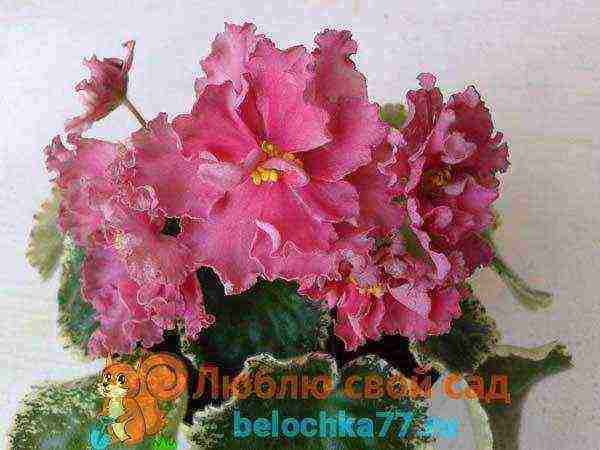 Variety Chic poppy
Variety Chic poppy
This is a variegated, large-sized flowers with a wavy fringed edge. Flowers reach 6 centimeters in diameter. The edges of the petals are hollow, similar to ruffles. The color of the petals is different, from light pink to orange-red tones. The leaves are pubescent, spatulate, decorative. Light greens from the center discolor and turn into white tones, making them variegated. Sometimes the leaves turn completely white.
How to grow violets at home
Ampelny
Ampel violets are intended for growing in pots, hanging pots. They decorate balconies, loggias, hanging flower beds. Plants have multiple growth points. A large number of new shoots are formed on the sides. Long stems are directed downward. They need good lighting. They bloom throughout the year. In winter, the plant needs additional lighting.
Lituanica
 Lituanica variety
Lituanica variety
Ampel variety with large double inflorescences. The petals are slightly elongated, similar in shape to small dahlias. The color of the flowers is pink-peach. The edge of the petal has a more intense color. Leaves are densely pubescent, dark green, pointed at the end. The stem is elongated. The rosette is high, well leafy, growing to an impressive size.
Grinya
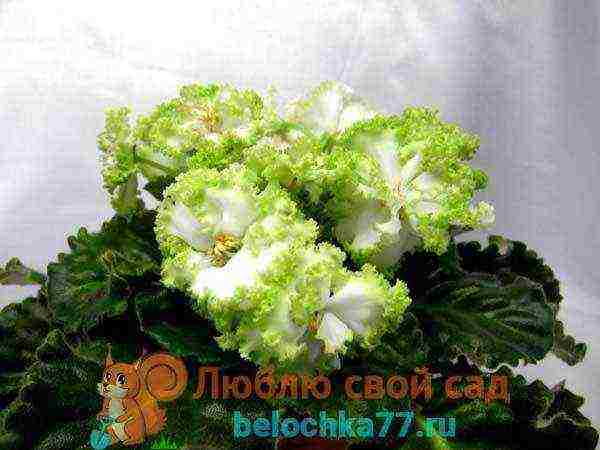 Grina variety
Grina variety
It is a slow growing hybrid. Flowers are large, semi- and densely double. At the bud stage, the flower is completely green. As it blooms, it grows larger and turns white. A wide green border remains along the edge of the corrugated petals. It disappears over time, after which the flower becomes snow-white. The rosette is thin, develops evenly. The leaves are wavy, rich green, hanging from the pot. Flowering lasts a long time.
Violets on the windowsill destroy privacy
White
White violets have large double flowers. The rosette is compact and consists of dark green leaves.
The bride's bouquet
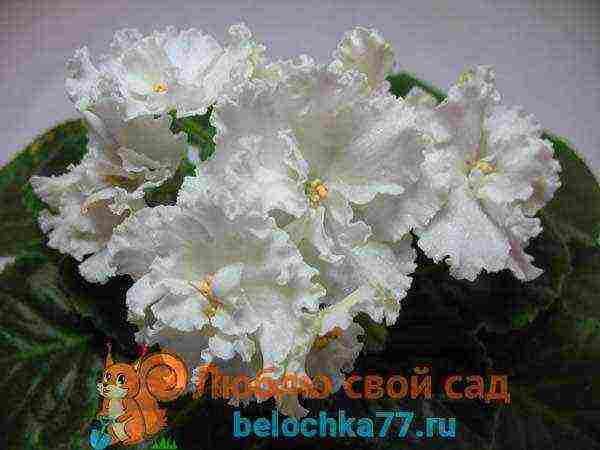 Sort Bridal bouquet
Sort Bridal bouquet
This richly blooming variety has large, star-shaped flowers in a pale white color. The edges are wavy. Flowers are like a bridal bouquet.
Whipped cream
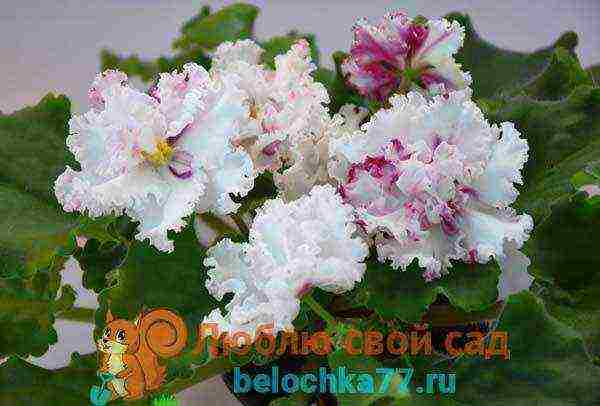 Whipped Cream Variety
Whipped Cream Variety
The flowers of this plant are white, large, double, lacy. The edge of the petal has a thin pink-crimson corrugated border. The socket is light, small. The foliage is slightly wavy.
Bridal bouquet
 Variety Wedding Bouquet
Variety Wedding Bouquet
The flowers are snow-white, very large, simple or semi-double. The center is bluish. Green corrugated border. Leaves are simple, light green. Standard size socket.
Pink
Georgia
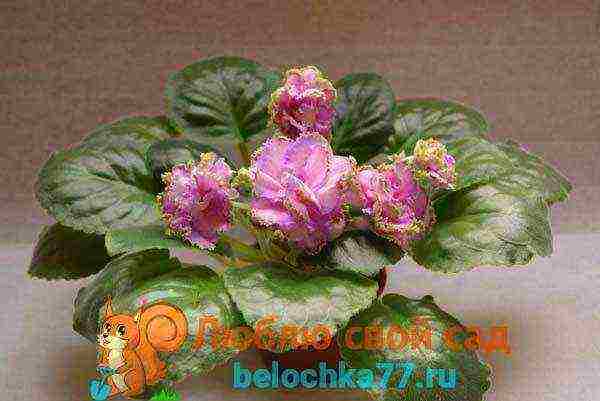 Georgia grade
Georgia grade
It is an abundantly flowering, very conspicuous variety. Flowers are bright pink, double, large. The edges are strewn with lilac specks. They are wavy, have a thin light green border. Flowers are formed on powerful, large peduncles. For abundant flowering, the variety requires proper keeping conditions.
Rose of Wind
 Wind rose variety
Wind rose variety
This delicate and very beautiful violet. The flowers are medium in size, about 4 centimeters in diameter, double, similar to lush garden roses. The petals are white-pink in color. Broken edges, corrugated light or dark pink. In some places, a green border is visible. The buds are located on a thin stem. The foliage is spreading, light green, forming a rosette. Several double flowers are formed on one peduncle.
Viola - growing from seeds
Purple
Don Juan
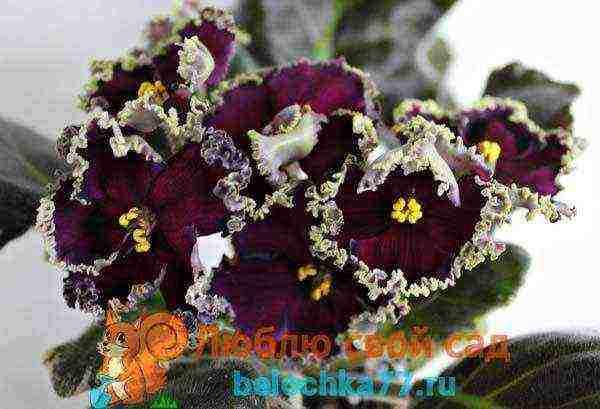 Don Juan variety
Don Juan variety
It is a cultivar with large, purple-plum, plain or semi-double flowers. The border is wide, strongly corrugated, bronze-green in color. The foliage is dark green with a pink edging, slightly wavy.
Macho
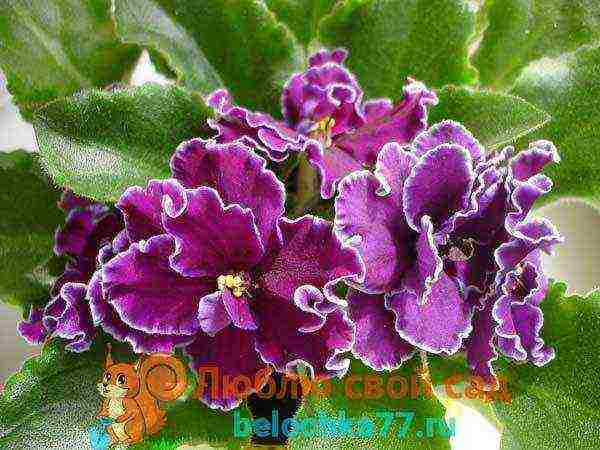 Macho variety
Macho variety
This is a semi-double chameleon variety. The flowers are claret-purple, almost black. The buds are densely arranged. A bright white border is visible along the edge of the petals. The flower turns purple in natural light, almost black, and burgundy when illuminated. Leaves are green, large, raised, ovoid. There are many peduncles, they develop and grow unevenly.
Duchess
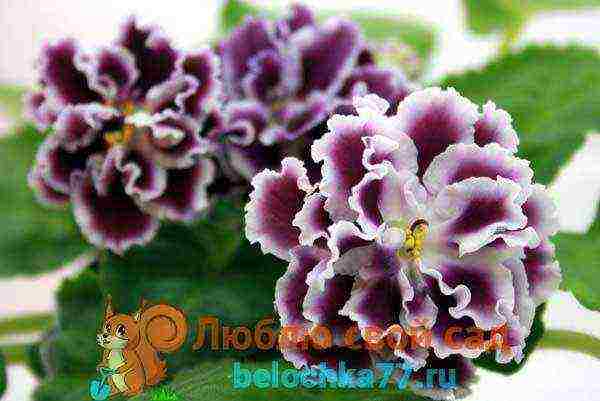 Variety Duchess
Variety Duchess
The variety pleases with excellent flowering. The flowers are huge, semi-double or double, the edges are wavy. Plum prints located in the center of the petals give decorativeness to the flowers. Powerful socket. The foliage is dark green, quilted, with noticeable veins.
Water
 Variety Water
Variety Water
Variety with large purple-blue flowers. At the edges, they have lighter fragments and abundant green ruffle. The dorsum of the corolla is lighter. Peduncles are low, strong, hold 4-6 spherical flowers. The leaf is green, quilted, wavy along the edges. The outlet is medium. Flowers open gradually, in cool weather they last for more than a month. The beauty of the variety is fully revealed in the second bloom.
Violet varieties: video
There are quite a few varieties and varieties of indoor violets, and each grower can choose them to his liking. Proper care allows you to preserve the peculiarity of a particular variety, preserving its uniqueness and beauty.


